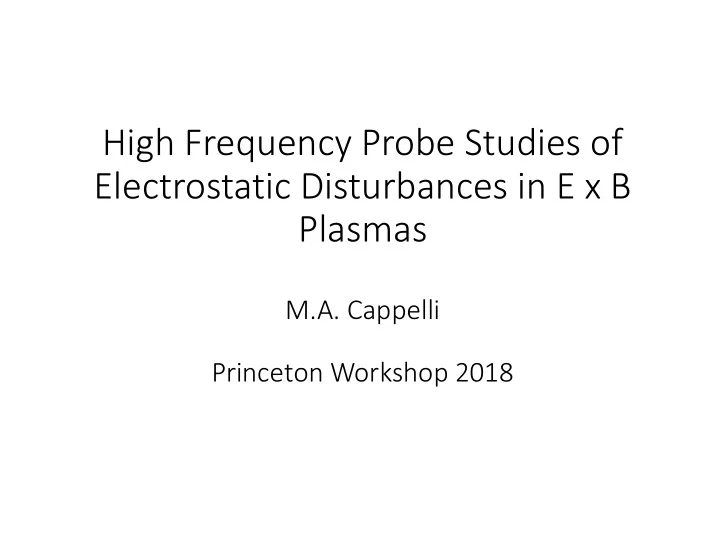

High Frequency Probe Studies of Electrostatic Disturbances in E x B Plasmas M.A. Cappelli Princeton Workshop 2018
Motivation • renewed interest in transport with new theories/simulations • need for more validating data (inside and outside the channel) • early HF probe data: • Guerrini and Michaut 1999 (single probe – 0.35 m beyond exit, high frequency) • Lazurenko et al, 2008 (probes beyond exit- correlation in activity with I-phase) • Litvak et al., 2004 (double probe – azimuthal wave in ionization zone) Litvak et al, 2004 Guerrini, 1999
Experiments at Stanford (~2010) • A. Knoll thesis (now at Imperial College London) • unpublished • triple probes, good frequency response to ~20 MHz • moderate Nyquist spatial frequency (resolve k = 3100 – 4200 rad/m) • inside thruster channel Stanford extended channel thruster Triple probe fits in insulator slot Extended channel
High Frequency Features Krypton Xenon 5 MHz 10 MHz Xenon 20 sccm 100V, 100 Gauss -1.5 cm (inside) Krypton 30 sccm High Frequency 150V, 100 Gauss High Frequency Features Features 0.5 cm beyond exit • distinct features seen in the 2-10 MHz range • all three probes showed similar spectra • independent of probe rotation (not shadow effects of probes) • features less distinct with krypton vs xenon • discharge operated at low voltage to minimize probe intrusion
Coherent Directionally-Favored Structures Representative Directional Map from Wavelet Analysis tilted-cathode +E x B directed to cathode Azimuthal (-ExB) Positive angle: E x B Negative angle: - E x B < p /2: cathode directed <- p /2: cathode directed > p /2: anode directed >- p /2: anode directed
Xenon - Low Voltage – Upstream of Exit 100 V E x B cathode- tilted broad underlying Xenon isotropic 20 sccm 100V, 100 Gauss turbulence -1.7 cm (inside) x 10 6 x 10 6 strong anode-directed (4 MHz, ~10 cm) exit • two coherent features • anode directed axial waves • tilted azimuthal waves • underlying isotropic “turbulence” • artifact or cascades? anode probe location
Xenon - Low Voltage – Upstream of Exit 100 V E x B cathode- tilted Local E/B Xenon 20 sccm 100V, 100 Gauss -1.7 cm (inside) x 10 6 strong anode-directed (4 MHz, ~10 cm) exit • Phase velocity of disturbances are spread over a broad range • 0.2 – (>) 1.5 x10 6 m/s • of order the drift velocity anode probe location
Xenon - Higher Voltage – Upstream of Exit 150 V Local E/B Xenon 20 sccm 150V , 100 Gauss -1.7 cm (inside) x 10 6 x 10 6 exit • counter-propagating azimuthal waves emerge • V p ~0.25 E/B, l ~ 2.5 cm • strong, broader disturbances in the +E x B directions at higher V p anode • varying wavenumber (~10 cm) probe location • k-space dispersive
Xenon - Higher Voltage – Beyond Exit Similar -1.7 cm +0.5 cm Xenon 20 sccm 150V , 100 Gauss -1.7 cm (inside) x 10 6 x 10 6 exit exit anode anode probe location probe location
Magnetic Field Matters (Still Beyond Exit) 100 G 65 G broad distribution in the +ExB (cathode and anode directed) Xenon Xenon 20 sccm 20 sccm 100V , 100 Gauss 100V , 65 Gauss +0.5 cm (outside) +0.5 cm (outside) x 10 6 x 10 6 x 10 6 exit • dramatic changes • emergence of higher frequency • favors – negative E x B • lower frequency has strong azimuthal direction anode • dispersion at lower B (frequency) probe location
Xe vs Kr (Still Beyond Exit) – High Voltage Kr Xe cathode-directed Krypton Xenon activity 30 sccm 20 sccm 150V , 100 Gauss 150V , 100 Gauss +0.5 cm (outside) +0.5 cm (outside) x 10 6 x 10 6 exit • Kr seems stronger in intensity • …but somewhat similar dispersion • cathode and anode-directed waves • weak underlying isotropic features • - E x B disturbances stronger in Kr anode probe location
Summary (Generalizations) • spectra dominated by 2- 10 MHz “coherent” features of relatively long wavelength [longer than the Nyquist limit of 2 mm] • some underlying “turbulence” (isotropic/k -space dispersion) • frequencies: ion transit (ion acoustic?) • velocities: closer to E/B (drift?) • consistently see cathode and anode-directed waves • sometimes see counter-propagating azimuthal structures • behavior depends on location, voltage, magnetic field (and less so on the gas) ”Long” wavelength disturbances and transport?
Supplemental Material
Supplemental 4 – 6 MHz Pass Filter Xenon Xenon 20 sccm 20 sccm 150V , 100 Gauss 150V , 100 Gauss 4-6 MHz pass fiter 4-6 MHz pass fiter Xenon 100V Xenon 150V favored E x B directed activity within the channel Krypton 30 sccm 100V , 100 Gauss 4-6 MHz pass fiter Krypton 100V
Supplemental 7 – 13 MHz Pass Filter Xenon 150V Xenon 100V Xenon Xenon 20 sccm 20 sccm 100V , 100 Gauss 150V , 100 Gauss 7-10 MHz pass filter 7-10 MHz pass filter Krypton Krypton 100V 30 sccm 100V , 100 Gauss 7-10 MHz pass filter
Supplemental 4 – 6 MHz Pass Filter Xenon Xenon 20 sccm 20 sccm 150V , 100 Gauss 150V , 100 Gauss 4-6 MHz pass filter 4-6 MHz pass filter Xenon 100V Xenon 150V Krypton 30 sccm 100V , 100 Gauss 4-6 MHz pass filter Krypton 100V
Supplemental 7 – 13 MHz Pass Filter Xenon Xenon 20 sccm 20 sccm 150V , 100 Gauss 150V , 100 Gauss 7-10 MHz pass filter 7-10 MHz pass filter Xenon 100V Xenon 150V Krypton 30 sccm 100V , 100 Gauss 7-10 MHz pass filter Krypton 100V
Supplemental 4 – 6 MHz Pass Filter 7 – 13 MHz Pass Filter Xenon Xenon 20 sccm 20 sccm 100V , 100 Gauss 100V , 100 Gauss
Supplemental Higher Resolution Around 10 MHz Xenon Krypton Xenon Krypton 20 sccm 30 sccm 100V , 100 Gauss 100V , 100 Gauss exit exit probe location probe location
Recommend
More recommend